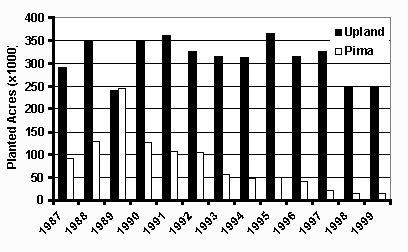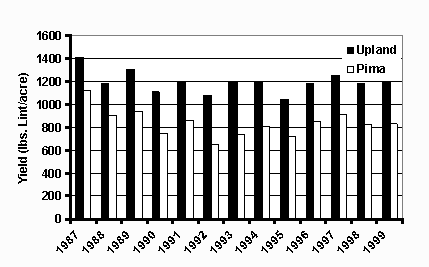As we close the 1999 season and the last season of the decade (century/millennium) we should review last season with great interest, while also considering some of the patterns we have experienced during the 90s. Figures 1 and 2 outline the yields (lbs. lint/acre) and the acreages planted to Upland and Pima cotton in Arizona (1989 – 1999). The 1990’s have been a very challenging period for the Arizona cotton industry and despite many obstacles, the yields have remained remarkably consistent over this period of time. The 1990 season is often referred to as the infamous pink bollworm year when we also experienced a very strong monsoon season. The 1992 season was marked by the problems (yield and quality) suffered in many areas due to whitefly infestations. The 1995, 1998, and 1999 seasons were marked by cool, wet spring planting seasons and strong monsoons. The largest acreage of Pima cotton was planted in 1989 with 245,000 acres. During the subsequent years, Pima acreage in this region has moved to the San Joaquin Valley and the "land of milk and honey". In 1999, 11,200 acres of Pima cotton were harvested in Arizona. Transgenic cotton varieties were first available commercially in 1996, and Arizona has experienced one of the most rapid transitions in planting various transgenic varieties of any cotton-producing state. The involvement of the federal government with cotton production (and agriculture in general) changed dramatically with the passage of the 1996 Federal Agricultural Improvement and Reform Act (or Freedom to Farm Act). This new farm bill "decoupled" the price support payments from acreage reduction requirements and replaced them with Agricultural Market Transition Act (AMTA) payments. Now as we end the 90s, farmers are facing extremely low market values for cotton lint. Certainly, these are challenging times for agriculture and cotton production in Arizona. The survival of many farms in this region will depend to some extent on how farmers and farm managers adapt to the current conditions and anticipate what is ahead. The development and application of new technologies may be very important to this adaptation and survival process. Also, the use and application of existing technologies may be important as well.
The 1999 season will probably be remembered as one with nearly record low market values for cotton lint. As a result, budgets to support production costs were limited on many farms in the region. A total of 250,200 acres of cotton was planted in 1999 (239,000 acres Upland and 11,200 acres Pima). Overall, the 1999 crop was late in planting, development, maturity, and harvest in some areas. A significant amount of variability in crop growth patterns and yield was experienced across the state this year. At the closure of the 1999 season, the USDA is estimating average yields of 1,155 and 814 lbs. lint/acre for Upland and Pima cotton in Arizona. However, despite all of the difficulties experienced at the beginning of the season, the 1999 crop has performed relatively well. The 1999 cotton season is not going to be a record setting year in terms of yield, but based on the potentials that were evident by early July, it is actually quite impressive that many growers were able to recover fields as well as they did.
The 1999 season began with an exceptionally cool and wet spring planting season. This resulted in delayed planting dates and high rates of replanting in many areas. For example, in parts of central Arizona, virtually all of the cotton planted in March was replanted in April following an early April storm on Easter Sunday that deposited snow in the Marana area and higher elevations, and was followed by a period of very cold weather. Many fields across the state and region experienced poor seedling vigor in the early stages of the season with increased levels of risk and exposure to pests (e.g. diseases such as Rhizoctonia solani and some insects). Unfortunately, a continuing pattern of storms and cool windy weather persisted for several weeks in the spring extending well into the month of May that served to slow plant (root and shoot) development. Many fields experienced a late formation in the first fruiting branch, often occurring at mainstem node number eight or above. Also, a high rate of early square abortion was experienced in 1999 due to wind, thrips, lygus, and water stress. Poor plant vigor was noticeable in many fields even into the early stages of blooming. The transition to hot and dry weather patterns was quite rapid in early June for most cotton growing areas in Arizona. Thus, growing conditions improved dramatically if water was not limiting during most of the month of June. However, in late June the summer monsoon season began, noted by an increase in the humidity and dewpoint temperatures. The 1999 monsoon turned out to be a long and wet one and continued into mid-September. Fortunately, however, the monsoon season was not accompanied by extremely hot weather. In fact, by Arizona standards, the 1999 summer was a relatively "cool" one. As a result, monsoon-related crop stress, often noted by high rates of fruit loss and abortion, was not a significant factor in many cotton-growing areas in 1999, with only periodic heat stress impacting cotton fields. One factor that was a persistent problem in many areas in 1999 in Arizona was lygus bug infestations. Lygus damage was particularly severe in parts of central Arizona in 1999. This seemed to be accentuated in areas with higher acreages of other host crops for lygus, such as seed alfalfa fields and/or forage alfalfa fields that were not irrigated in the summer months.
The 1999 season is concluding with reasonable yields, particularly considering the difficulties experienced in the early portions of the season. Overall, the 1999 Arizona cotton crop has good quality. However, high micronaire fiber was common in many parts of Arizona. High micronaire (> 4.9 micronaire readings) commonly result in price discounts applied to the crop. This is particularly detrimental in years when the market value of the lint is already extremely low. Thus, the challenges associated with the high micronaire trends that have been experienced in Arizona in recent years are important for us to deal with as we look toward a new year and a new decade of cotton production in this region.
Figure 1. Planted acres of both Upland and Pima cotton in Arizona from 1987 – 1999.
Figure 2. Yield of both Upland and Pima cotton in Arizona from 1987 – 1999.
Issued in furtherance of Cooperative Extension work, acts of May 8 and June 30, 1914, in cooperation with the U.S. Department of Agriculture, James A. Christenson, Director Cooperative Extension, College of Agriculture and Life Sciences, The University of Arizona.
The University of Arizona is an equal opportunity, affirmative action institution. The University does not discriminate on the basis of race, color, religion, sex, national origin, age, disability, veteran status, or sexual orientation in its programs and activities.
Any products, services, or organizations that are
mentioned, shown, or indirectly implied in this web document do not imply
endorsement by The University of Arizona.
Information provided by Jeffrey C. Silvertooth, silver@ag.arizona.edu
Extension Agronomist - Cotton, College of Agriculture, The University of Arizona.
Material written 14 December 1999.
Home | Cotton | Advisories
document located at: http://cals.arizona.edu/crops/cotton/comments/dec1999cc.html
Copyright © 2001 University of Arizona,
College of Agriculture and Life Sciences
Webmaster: Al Fournier (acis@ag.arizona.edu)

